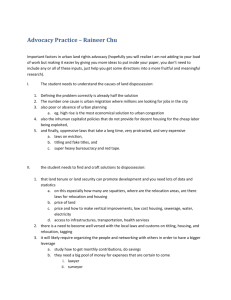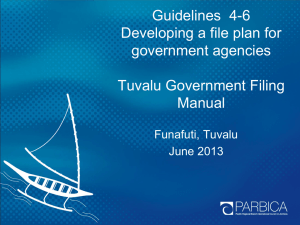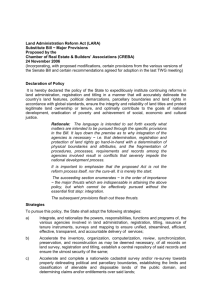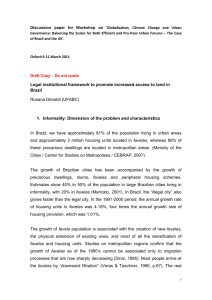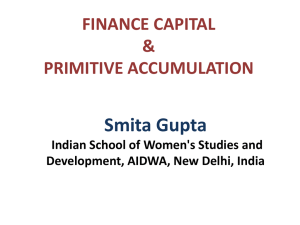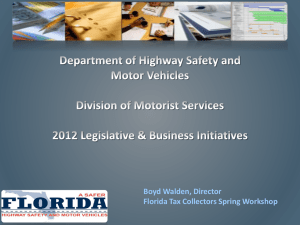Project: 5220173 Honduras - Land Tenure and Property Rights Portal
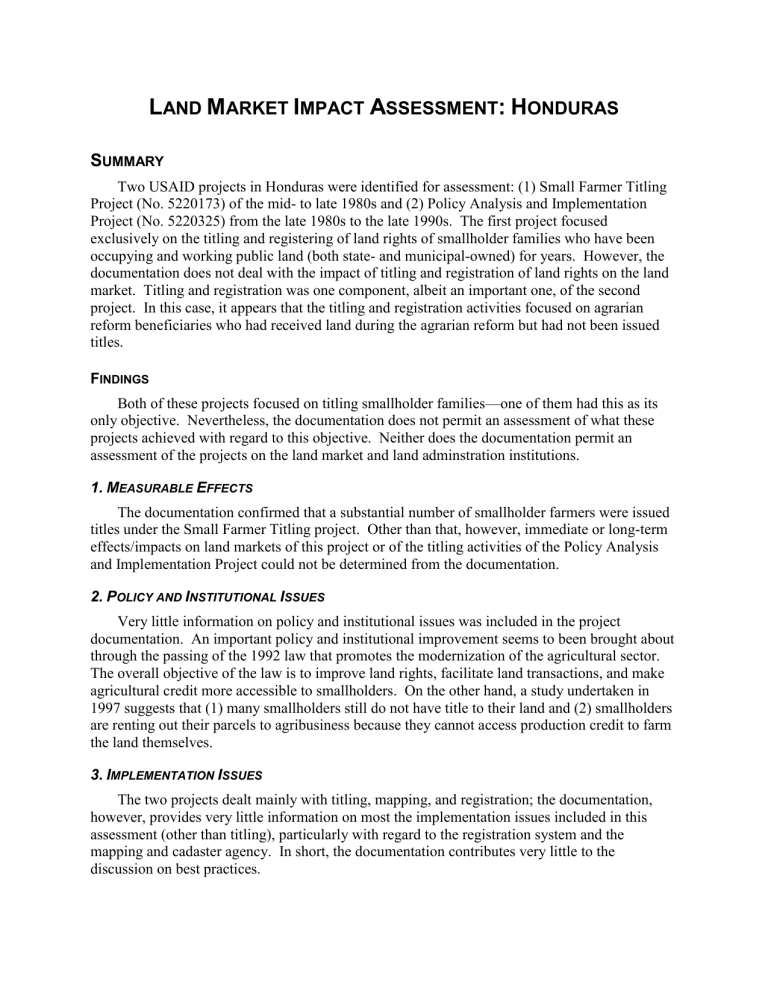
L AND M ARKET I MPACT A SSESSMENT : H ONDURAS
S UMMARY
Two USAID projects in Honduras were identified for assessment: (1) Small Farmer Titling
Project (No. 5220173) of the mid- to late 1980s and (2) Policy Analysis and Implementation
Project (No. 5220325) from the late 1980s to the late 1990s. The first project focused exclusively on the titling and registering of land rights of smallholder families who have been occupying and working public land (both state- and municipal-owned) for years. However, the documentation does not deal with the impact of titling and registration of land rights on the land market. Titling and registration was one component, albeit an important one, of the second project. In this case, it appears that the titling and registration activities focused on agrarian reform beneficiaries who had received land during the agrarian reform but had not been issued titles.
F INDINGS
Both of these projects focused on titling smallholder families—one of them had this as its only objective. Nevertheless, the documentation does not permit an assessment of what these projects achieved with regard to this objective. Neither does the documentation permit an assessment of the projects on the land market and land adminstration institutions.
1.
M EASURABLE E FFECTS
The documentation confirmed that a substantial number of smallholder farmers were issued titles under the Small Farmer Titling project. Other than that, however, immediate or long-term effects/impacts on land markets of this project or of the titling activities of the Policy Analysis and Implementation Project could not be determined from the documentation.
2.
P OLICY AND I NSTITUTIONAL I SSUES
Very little information on policy and institutional issues was included in the project documentation. An important policy and institutional improvement seems to been brought about through the passing of the 1992 law that promotes the modernization of the agricultural sector.
The overall objective of the law is to improve land rights, facilitate land transactions, and make agricultural credit more accessible to smallholders. On the other hand, a study undertaken in
1997 suggests that (1) many smallholders still do not have title to their land and (2) smallholders are renting out their parcels to agribusiness because they cannot access production credit to farm the land themselves.
3.
I MPLEMENTATION I SSUES
The two projects dealt mainly with titling, mapping, and registration; the documentation, however, provides very little information on most the implementation issues included in this assessment (other than titling), particularly with regard to the registration system and the mapping and cadaster agency. In short, the documentation contributes very little to the discussion on best practices.
D OCUMENTATION
Documentation for these two projects was very spotty and not adequate for an assessment of
USAID’s projects on the land market in Honduras. No project design is available for the Small
Farmer Titling project, only a final report by the cadastral contractor and an external evaluation report are available. There are no reports by the other contractors, no project completion report, or an impact evaluation report.
For the Policy Analysis and Implementation Project, the project design document is not available, only the Project Authorization document and a project amendment midway through the life of the project. Neither are there any end of project reports such as contractor/grantee reports and internal or external evaluation reports. A study undertaken by the contractor on the particular topic of land rentals was useful in providing some information about the land market in Honduras.
1.
D ESCRIPTION OF H ONDURAS P ROJECTS
Two USAID projects in Honduras were identified for assessment: (1) Small Farmer Titling
Project (No. 5220173) of the mid- to late-1980s and (2) Policy Analysis and Implementation
Project (No. 5220325) from the late 1980s to the late 1990s. Since the second project continued to implement titling of agricultural land, these two projects will be reviewed together.
1.1
S MALL F ARMER T ITLING P ROJECT (N O .
5220173)
Only two documents were available for the Small Farmer Titling Project (1984-1989), a final contractor report from the firm contracted to give technical assistance to the Honduras cadastral service and a final evaluation report written in 1992. No final report was available on the work done by the Honduras titling agency on the titling and registration aspect of the project; however, some information on titling activities was included in the evaluation report. Since there was no project design document available, it is difficult to determine what the objectives and were, to assess whether the project reached its objectives, and to determine how well the activities were carried out.
It appears that the project had two general objectives: (1) to expedite the titling of individual small farmers who are occupying national and municipal lands (sometimes called ejidal land), and (2) to create inter-institutional mechanisms between the agricultural titling agency (Instituto
Nacional Agrario, INA) and the national cadaster office (Direccion Ejecutiva Catastral, DEC).
The project agreement was signed in August 1982, technical assistance from Clapp and Mayne,
Inc for the cadastral component began in March 1984, and the closing date was extended twice finally terminating on 31 December 1990.
According to Falck’s 1992 (pg. 3) completion report, the general goal of this project was to
“increase food production, employment and incomes of rural Hondurans by expanding the benefits of private property ownership to small farmers.” This was to be done by “establishing a functioning mechanism for the granting of fee simple titles for national lands occupied by
Honduran small farmers.” This titling project consisted of three activities: (1) promotion and identification of eligible beneficiaries, (2) delineation and mapping of parcels, and (3) titling and
2
registry. These three activities were to be carried out in seven departments
1
and were to directly benefit 70,000 rural families. During implementation, an eighth department was added and the number of families to be titled was reduced to 40,000.
At the completion of the project, 40,288 families had been titled and registered; 9,576 (24%) of these titleholders were women (Falck 1992: 4). According to Falck’s report (pg. 4), 3.7 M
(million?) hectares of state and municipal land were delineated (mapped). Not all of this land underwent titling because the delineation included state and municipal parcels not titled for any number of reasons: land not occupied, ineligible occupiers, etc. Out of a total of 368, 204 parcels delineated, 55,029 parcels were titled covering a total area of 330,424 hectares. A curious element of this project is that, in order to reduce processing time and paperwork, the project decided to issue titles by beneficiary, not by parcel. If a smallholder was occupying more than one discreet parcel, therefore, s/he was given only one title.
Another change that had very positive consequences for smallholder families was the recommendation by the Land Tenure Center to lower the size limit of titled parcels. Honduras’
1974 agrarian reform legislation had stipulated that only parcels over 5 hectares could be titled.
This legislation was later amended in 1981 to permit smaller parcels with coffee trees to be titled. As the delineation of smallholder parcels on public land demonstrated that two-thirds of the parcels were under 5 hectares, the Land Tenure Center recommended that the minimum size of parcel (whether planted to coffee of not) that can be titled be lowered from 5 hectares to 1 hectare. In 1992, the Ley para la Modernizacion y el Desarrollo del Sector Agricola approved the titling of land parcels as small as 1 hectare.
Falck (1992) cites the results of two external evaluations done by the Land Tenure Center
(these evaluations were not available from DEC). The conclusions of the evaluations demonstrate mixed results: (1) the amount of investment on titled and untitled parcels was not significantly different, (2) titled parcels have more credit access than untitled parcels, (3) title can sometimes increase insecurity, (4) land transfers for titled parcels had not increased, and (5) farmer’s perception was that titled land had a higher value (60% higher) than untitled land.
1.2
P OLICY A NALYSIS AND I MPLEMENTATION P ROJECT (N O .
5220325)
The Policy Analysis and Implementation Project (1987-1997) was a large policy-oriented project, with the agricultural sector being one focus of policy activities. Within the agricultural sector, policy analysis on land titling and implementation activities was one component. For this project, three documents were available, however only one of them provided information on the titling activities, Project Agreement Amendment No. 5 (1992). There are no project design document, end-of-project reports, or evaluation reports. The Project Amendment document does provide some minimal information on the land titling activities to be carried out. The
Authorization for the Policy Analysis and Implementation Project document (1987) addressed concerns and potential problems that had been expressed about the Project Paper; no mention was made of titling activities. The report on the study (Cruz and Munoz, 1997) regarding the renting and joint enterprise contracts being done between agrarian reform groups and commercial firms did give some insight into that type of market activity (land rentals), the titling situation of these groups, and the possibilities they have to access credit.
1 Honduras has a total of 18 departments. The project documents did not explain why these seven departments were selected.
3
From the 1992 Project Amendment document (pp. 2-3), it is evident that titling was to be one of the principal priorities of this project. It is not clear whether there were any titling activities between 1990 (when the titling activities of the prior project ended) and 1993 (when titling activities under Amendment No. 5 were to begin). In the process of providing technical assistance for the titling process, the project was to come up (1) with mechanisms that would make titling self-financing and (2) with procedures to institutionalize a self-sustaining title registry process. In addition, project advisors would upgrade cadaster and property registry systems and decentralize the cadaster and property registries.
It appears that the titling activity was to target agrarian reform groups (in contrast to the former project which targeted smallholders already occupying and farming public land). These groups came out by the Agrarian Reform process of the 1970s and generally consisted of production cooperatives, farmer associations, and peasant groups; one characteristic these groups had in common is that land reform process had been adjudicated the land to the group. Often, however, the agrarian reform process did not include titling the land. The 1992 agricultural modernization law gave these groups the option of subdividing the land among group members or continuing in a collective enterprise, or to set up a mixed tenure (individual and group property) form. One purpose of this project was to facilitate the titling of agrarian reform sector land, either to individual group members or to the group. Among the outputs expected from the titling component of the project were: (1) rapid and self-sustaining titling and registry systems and (2) improved land transfer mechanisms for smallholders (pg. 8). During the years 1993 to
1996, 10,000 titles per year were to be issued and registered (for a total of 40,000 titles), land sales were to increase by 20% (over 1991 land sales) by the year 1994, and land invasions were to decrease to 0 by 1994.
As already stated, because of the lack of project reports and evaluations, we cannot assess whether any of the activities outlined in Amendment No. 5 around titling, registry of titles, land transactions, and the linking of cadaster and registry information were carried out. Nor is it possible to determine the level of outputs. The study done by Cruz and Munoz on the renting out of agrarian reform sector land and joint farming arrangements (similar to contract farming or reverse sharecropping) with agribusiness firms suggests that as of 1997 many of these agrarian reform enterprises did not have title to the land: of the 81 enterprises included in the nationallevel study only 25 groups (31%) had a title. Another surprising result from the study was the fact that in spite of not having title to their land, these groups were able to reach financing arrangements with agribusiness groups for the planting of cash crops. One of the main obstacles for smallholders, particularly in the production of cash crops, is the lack of credit—some of the joint farming arrangement provided smallholders with credit and/or inputs for the production of cash crops. The authors of the study concluded that these joint venture-type production arrangements (similar to contract farming and reverse sharecropping) and the rental contracts generally were helpful to members of the group in that it provided them with income for planting their own subsistence crops and paying off the agrarian reform debt.
4
2.
A
SSESSMENT OF
H
ONDURAS
P
ROJECTS
There are three general questions to be answered from the available documents, if possible:
1.
What evidence is there which will enable an estimate of the overall success of land entitlement projects in reaching their developmental goals?
2.
How have the policy and institutional factors which affect the success of these activities been identified and assessed?
3.
How have the implementation techniques and approaches affected activity success?
2.1
M EASURING E FFECTS (I NCLUDING
“S
UCCESS
”)
AID programs designed to improve land markets and protect property rights are expected to contribute to economic growth and agricultural development. However, the contributions of land markets and property rights investments to growth and development operate through numerous intervening variables. The chain of causation is quite long and easily interrupted by failures in implementation as well as by the influence of factors not included in the projects.
Concerning the chain of causation, we have identified the following causal links:
D IRECT E FFECTS
Statistics on direct effects
What was achieved in the project to improve entitlement to land by the poor, such as the number of “titles” issued?
The first project, between 1984 and 1990, titled 40,288 smallholder families occupying and farming public lands (Falck 1992). The available documentation had no information on how many titles were issued during the second project.
What evidence is there that these statistics include fictitious “titles”? Magnitude?
No information or evidence was found in the available documentation.
To what extent do “titles” contain errors which weaken their validity? To what magnitude?
One of the reports (Clapp and Mayne 1989) for the Small Farmer Titling project mentioned that the Honduran government agency (INA) in charge of the titling process complained about the high number of errors being made in the delineation/mapping of parcels. The report mentions that measures had been put into effect to lower delineation errors. Other than this mention, the available documentation did not have information on errors or quality control mechanisms.
What are the characteristics of the beneficiaries (gender, ethnicity, race, and class)?
In the first project, 24% of the smallholders issued titles were women (Falck 1992). No other information on ethnicity, race, or class is available. No information on any characteristics is available for the second project.
What percentage of land has marketable titles that are also legally registered?
5
All titled land was also supposedly registered; no direct evidence from project reports on registration of titles (Falck 1992, Clapp and Mayne 1989). According to Honduran legislation, all titled land and registered land is marketable.
Legal provisions
Is the legal framework which protects “legal entitlements” adequate? That is, does clear and applied legislation provide for the holder(s) of agricultural land:
While not much information on legal entitlement was included in the documentation, two reports
(Cruz and Munoz 1997; Falck 1992) did mention that the 1992 Ley para la Modernizacion y el
Desarrollo del Sector Agricola removed many of the constraints that had been placed on agrarian reform beneficiaries to participate in land markets.
To undertake a range of uses that are broadly consistent with existing social practices?
This issue is not addressed in the project documents.
To sell the property?
Yes.
To lease the property?
Yes.
To bequeath the property?
This issue is not addressed in the project documents.
To be compensated in cases of public acquisition of the rights to the land?
This issue is not addressed in the project documents.
To use the land to secure loans?
The projects assume this right.
To be protected by courts concerning their rights to the land?
This issue is not addressed in the project documents.
For women and men, and for all ethnic groups to be equal before the law with respect to ownership of agricultural or urban land?
This legal issue is not addressed in the project documents.
For their private property rights to be guaranteed in the Constitution?
The projects assume this protection.
Institutional protection
Is the “public registry” where titles are recorded: accessible, managed transparently without significant corruption, staffed by professional and well-paid staff, with sufficient facilities, with secure document storage and retrieval capacities?
No description is included in the project documents regarding the Registry Office, the registration process, nor the registration activities of the project.
6
Is the legality of land titles maintained as transactions occur which change the holder of the entitlement or change parcels boundaries?
This issue is not addressed in the project documents.
Do high transaction costs (budgetary feasibility) undermine the sustainability of entitlements produced under the project? What approaches have been used to minimize this problem?
This issue is not addressed in the project documents.
S ECOND S TAGE E FFECTS
What evidence exists of a measurable relationship between improved entitlements to land by the disadvantaged and:
increased volume of land transactions?
In the first project, land transactions of titled parcels did not increase (Falck 1992). The project documentation dealing with this issue for the second project was not available.
increased value of the land?
The first project indicated that smallholders who had received titled perceived that the value of their land had increased by 60% (Falck 1992). No information on land values was available for the second project.
reduced transaction costs?
This issue is not addressed in the project documents.
improved access to capital markets?
The first project indicated that smallholders with titled parcels have more credit access than those with untitled parcels—no statistics on credit access was included (Falck 1992). A study from the second project indicated that non-titled agricultural cooperatives and other groups were able to enter into contracts with agro-business enterprises for the financing of cash crop production.
Conditions of these contracts seem to approximate sharecropper or contract farming arrangements (Cruz and Munoz 1997).
T HIRD S TAGE E FFECTS
What evidence is there that the project outputs (direct effects) plus the second stage effects have combined to produce:
increased investment in land, more intensive use of land?
An evaluation for the first project revealed that investment levels for titled and untitled land were the same (Falck 1992). Available documentation for the second project does not include information on this issue.
better protection and conservation of land?
The issue of land conservation/degradation is not addressed in the project documents.
increased income from land?
7
The issue of increased income from land is mentioned in the study report on leasing and jointinvestment contracts (Cruz and Munoz 1997): land holders stated that income from these contracts were useful in paying off the agrarian reform debt and in financing the production of some of their crops. However, it should be mentioned that many of these landholders did not have title to land, therefore the ability to enter into financial contracts apparently does not always require a land title.
Have benefits been evenly distributed or have they flowed primarily to the relatively rich or the relatively poor?
The issue of social equity is not addressed in the project documents.
Was land fragmentation a problem? If so, to what extent was it mitigated?
The issue of land fragmentation is not addressed in the project documents.
Is there evidence of environmental degradation following legal entitlements, and if so, what are the possible options to mitigate this problem?
The issue of environmental conservation/degradation is not addressed in the project documents.
What have been the contributions of the project to similar efforts in other countries and/or to other similar programs within the country?
This issue is not addressed in the project documents.
2.2
P OLICY AND I NSTITUTIONAL I SSUES
How do policy and institutional factors determine, a priori , the feasibility of implementing programs to improve land markets and protect property rights? That is, what are the necessary and sufficient institutional transformations
legal, informal, cultural, economic
that must accompany programmatic initiatives to facilitate the development of markets in land and related assets?
To what extent does political commitment (or political will)—as distinct from anticipated economic benefits—drive a government’s decision to support programs designed to improve land markets and property rights?
The 1992 Ley para la Modernizacion y el Desarrollo del Sector Agricola appears to promote the titling and registration of land rights and to remove obstacles from the land market transactions
(Cruz and Munoz 1997). In addition, it appears that recommendations made by the evaluation studies of the first project to promote titling and land markets were adopted by Government
(Falck 1992).
Have there been effective “champions” of the program in the public and private sectors over the life of the program?
No mention of a “champion” is included in the project documents.
What evidence is there that support for the project extends beyond the project employees and contractors?
No information on project support is included in the project documents.
8
Has USAID contributed to shaping the “right” policy environment? What are the necessary and sufficient elements of the “right” policy framework? Examples might include government support for: (1) private ownership of land, including the right to use land and transfer ownership of land; (2) providing people with legal title to land, formal or informal/customary; (3) legal concepts for different types of ownership, recognizing local custom and international norms; (4) an effective, transparent, and efficient title registration system, whether formal or informal; (5) land market professionals in the private sector; (6) requiring that transactions be registered; (7) investing in educating the public, including governmental officials, about the rights and responsibilities of private land ownership.
Other than the mention of recent legislation (Decree 78 in 1981, Ley para la Modernizacion y el
Desarrollo del Sector Agricola in 1992) that promotes the legal titling of land rights of smallholders and agrarian reform beneficiaries in order to increase land market activities including leasing, joint-investment agreements, access to credit, no other information on this issue is included in the project documents.
With regard to education, the Small Farmer Titling project did include a set of pre-titling activities at the regional level to carry out promotional campaigns for the identification of beneficiaries and to give legal support to titling teams. The available documentation did not have information on education and awareness programs for the titling component of the Policy
Analysis and Implementation Project.
To what extent have strong public and private land administration institutions at both the national and local levels been developed to protect the private and public interests in land?
No information on the strength or effectiveness of public and private land administration institutions is included in the project documents.
Are poor enforcement of property rights and poor definition of property owner responsibilities key constraints to well-functioning land markets (both sales and rental)?
The documentation offers both positive and negative answers. On the one hand, smallholders expressed insecurity with regard to their rights because of the slowness of INA (the government agency overseeing the titling of agrarian reform beneficiaries and smallholders on public land) to approve land transactions; the process is so lengthy and costly that smallholders at the receiving end of a land transaction are uneasy (Falck 1992). The 1992 legislation was supposed to correct this situation. On the other hand, agricultural cooperatives and other agrarian reform groups have been able to enter into rental and joint-investment contracts with agribusiness even when they have not yet received title to their land (Cruz and Munoz 1997).
To what extent is poor enforcement due to public and private sector corruption, lack of institutional capacity, or other causes?
No information on property right enforcement is included in the project documents.
To what extent do beneficiaries of land entitlement programs have access to financing needed to purchase land at affordable interest rates and for sufficient time periods?
Do credit institutions operate effectively in rural areas? Are they regulated? Are they fair and impartial? Are they willing to lend available funds to farmers at interest rates
9
that are within the capacity of agricultural enterprises to repay? What constitutes acceptable collateral?
No information on this issue is included in the project documents. The Cruz and Munoz (1997) study report does mention the financing of cash crop production by agribusiness concerns on agrarian reform sector land, but the report does not supply information on interest rates and other credit conditions. The Policy Analysis and Implementation Project apparently did have a land financing activity but no information was available in the documentation provided.
Are land and property taxes being used effectively to promote the optimal use (or sale) of land? Conversely, are land and property taxes an ineffective tool due to limited administrative capacity, lack of accurate land records, or other factors? What are the necessary components of an effective tax policy and administrative system?
No information on property taxation is included in the project documents.
What mechanisms have been effective in ensuring contract enforcement and dispute/conflict resolution (e.g., third party arbitration, legal aid centers)?
No information on conflict or dispute resolution is included in the project documents.
2.3
I MPLEMENTATION I SSUES
Assuming an appropriate policy and institutional framework, what key operational issues tend to hamper (or facilitate) implementation of programs to improve land markets and protect property rights? Such issues concern the actual implementation of specific steps and procedures that are essential
both in their presence and in their sequencing
to ensuring that land and related assets become “marketable.”
Is cost per beneficiary a key constraint in implementing the land entitlement and registration investments?
No information on cost per beneficiary or on its impact on titling/registration implementation is included in the project documents.
What evidence is there of corruption, particularly kickbacks, in the entitlement program? What has been done to minimize the corrupt practices and mismanagement in the program?
The available documentation did not have information on corrupt practices and mismanagement.
What has been the response of the government and USAID to mismanagement of project resources if it occurred?
The available documentation did not have information on corrupt practices and mismanagement.
2.4
I MPLEMENTATION AND B EST P RACTICES
What lessons for “best practices” emerge from the project? In the design of a titling/registration program, a number of options should be considered, and given the conditions and needs of the country, some decisions made. What options were chosen in the project and what recommendations for “best practices” might be made?
1.
Title versus Deeds Registration
10
The two main options for a registration program are: 1) Deeds system, where people deposit their title documents (privatization documents, sales contracts, wills, survey plans, etc) and the depository office only assures secure storage and access to those stored documents by people interested in the properties; 2) Title system, where the registration system maintains a map description of parcel boundaries and records of all rights to the properties so described including changes in rights or boundaries of parcels, typically with some sort of guarantee of the accuracy of these records in the registry. Which approach is better?
The Project Amendment document (1992: 2) for the titling component of the Policy Analysis and
Implementation Project mention that Honduras will develop regulations for implementing a
Folio Real registry system. No other discussion on this issue was found in the available documentation, other than a mention in the Small Farmer Titling project that titling (and therefore registration?) was being done by title holder rather than by parcel, with more that one parcel on a title if the holder had more that one parcel. It appears a Honduras used a deeds registration system.
2.
Sporadic versus Systematic Initial Registration
What experience did the project generate about the cost and effectiveness of sporadic registration (owner initiated legalization of title) versus systematic registration (project initiated legalization of title)?
The available documentation for both projects would seem to indicate that a type of systematic titling and initial registration was undertaken. At least for the Small Farmer Titling project, areas were identified for titling and titling and delineation teams were sent into these areas.
3.
New Base Maps from photography vs. Use Available Base Maps
Did the project use existing topographic base maps for first registration delineation of parcel boundaries or aerial photography, digital photography for the identification of property boundaries?
The Clapp and Mayne report (1989: 6-7) dealing with the cartography work does not mention how the maps are to be produced nor based on what information—it appears that existing maps were used and that perhaps parcel surveying was done. While the Project Amendment document
(1992: 2) for the Policy Analysis and Implementation Project states that cadastral map coordinates will be used, it does not mention how the base maps will be produced.
4.
Graphic Descriptions of Boundaries vs. Coordinate Based Corners
What procedure was used, with what precision requirements for describing parcel boundaries?
One of the reports (Clapp and Mayne 1989: 6-7) for the Small Farmer Titling project dealt with the delineation (mapping) component of the titling process. Although it states that a new property identification numbering system and property mapping system (including a new map format) were designed and installed, there is no information on the type of mapping system nor the precision requirements. The Project Amendment document (1992: 2) for the Policy Analysis and Implementation Project states that cadastral map coordinates will be used.
5.
Property Rights Initial Definition by Declarations of Land Commission Members vs.
Only Reference to Documented Rights
11
Local land commissions or outside technical agencies reviewing historical documentation can be used to identify boundaries and rights. What worked better in the project?
No information was included in the available documentation for either of the two projects on how property boundaries and rights were identified. None of the reports dealt directly and in depth with the titling activities.
6.
Use of Computers to Record “Entitlements” and their boundaries.
Did the field teams gather data and use it in digital format to record entitlements and boundaries or did they rely on paper recording techniques, or some combination?
A brief mention was made in the Clapp and Mayne (1989: 8) report for the Small Farmer Titling project that the project’s computer analyst “developed and installed a computerized information system on INA’s titling project.” It is not clear whether this means that titling data or administrative information was computerized; no other information was given on the information system itself. No information was available on this issue for the titling component of the Policy
Analysis and Implementation Project other than the mention that Honduras “will upgrade cadastre and property registry systems” (Project Amendment No. 5, 1992: 2).
7.
Area of parcels actually held vs. area stated in the privatization documents
Field measurements produce one estimate of parcel areas while title documents can contain other estimates, which may be “close” but hardly ever exactly the same. How are these discrepancies resolved?
No information was found on accuracy of parcel measurements and resolution of discrepancies for either of the two projects.
8.
Projects by Donors vs. Coordinating Entity for all Donor Projects
In some countries there is a land market project coordinating and implementing entity. All donors have to work through this entity. This is in contrast with other countries where donors did their “pilot” registration projects with different methods and concepts.
None of the documents for either of the two projects dealt with the issue of project coordination among donors.
9.
Centralized Registry Office vs. District Registrars
Some countries are constructing highly centralized and computerized registration systems, using a single data base to store the map and rights information, and with access to the data base through terminals under the control of professionals and businesses. In other countries the conditions for operating a centralized and computerized system are often— electricity shortages, transportation difficulties, a communication network which was rudimentary and untrustworthy, few people with any computer experience, lack of maintenance network. Also, the public access to centralized systems may be limited. Did the project create or contribute to a centralized or decentralized registration system?
The Project Amendment document (1992: 2-3) for the Policy Analysis and Implementation
Project mentions that Honduras will decentralize the rural and urban cadasters, and that decentralized property registers will be created at the municipal level.
10.
Public Information vs. Restricted information
12
It is often the intention that any member of the public has the right to inspect the property documents and parcel maps in the registry. What restrictions exist? What are the procedures for sharing digital information with other government and private sector agencies?
No information on the issue of public information restrictions was found in the available documentation for either of the two projects.
11.
Initial Registration and Registries: Paper based vs. Complete or Partial
Computerization
In some countries, the Registration Offices function with paper records, although some also have digital back up copies. Others work with completely digital records. What works better?
No information was found in the available documentation, for either of the two projects, on registration activities.
12.
Registration/cadaster as part of a Ministry vs. Independent Entity
Are the registration functions including parcel map maintenance housed in a single entity, or are the registration-cadaster functions institutionally separate? Are these entities part of line Ministries or are they independent?
No information was found in the available documentation, for either of the two projects, on registration activities. For the Small Farmer Titling project, both available reports mentioned that “project would assist to create interinstitutional mechanisms between the National Agrarian
Institute (INA) (which processes and issues the titles) and the National Cadaster Office (which delineates the land) to effectively coordinate their programs…” (Falck 1992: 2).
13.
Government vs. Independent Implementation
Is the project implementing entity “independent” of government, or is it a line agency, or is it temporary entity under a Ministry?
For the Small Farmer Titling project, it appears that the implementing agency is INA, a government agency that deals with agricultural land including titling, in close coordination with the National Cadaster Office (DEC). For the titling component of the Policy Analysis and
Implementation Project, it appears that a temporary entity, Agricultural Sector Policy Unit
(Unidad de Politica del Sector Agricola, UPSA), coordinated the titling activities done by INA.
14.
Institutional Coordination
Titling and registration improvement projects typically require the involvement of numerous public sector agencies. What mechanism was created to help facilitate this involvement?
For the Small Farmer Titling project, the titling agency (INA) and the cadastral agency (DEC) were supposed to create inter-institutional mechanisms for coordination of their fieldwork activities. For the Policy Analysis and Implementation Project, it appears that a temporary entity, Agricultural Sector Policy Unit (Unidad de Politica del Sector Agricola, UPSA), coordinated titling activities, mapping, and other activities.
15. Validation of first registration: displays vs. distribution of certificates.
13
The project work is typically done by contracted people, and the results of their work is validated in various ways: displaying in the communities the maps and title information or distribution of rights documents to the holders for them to review, or checking of the field work by other teams. Or some combination. What worked better?
The available documentation for both projects does not mention any validation activities.
16.
First registration done by contracted fieldwork for mapping and rights recording separately vs. unified contracts for mapping and rights recording.
In some countries the field work is done by contracting with companies or with individuals to do particular parts of the first registration job: preparation of the base maps, updating of maps and preparation of parcel maps, filling in of property documents, digitizing property information, digitizing of base and parcel maps, and correction of the maps and property documents, physically and digitally. Another option is to contract with one entity for all of these activities. Which is better?
The available documentation for the Small Farmer Titling project suggests that government agencies (INA for titling, DEC for mapping, and the Registry for registration) undertook the separate activities. Available documentation for the Policy Analysis and Implementation Project does not address this issue, however the description of activities in the Project Amendment document suggests that separate government agencies (with the exception of parcel surveying) undertook the activities for the titling process. The Project Amendment document (1992: 2) states that INA will begin to contract property survey and delineation functions to private firms, rather than develop that capacity within INA.
17. Pilot areas first vs. full national programming
Which approach is better: A pilot project followed by “roll-out” implementation or a phased national implementation plan?
The available documentation for these two titling projects in Honduras does not permit this type of assessment. It is not clear whether the Small Farmer Titling project was a pilot project or not—8 departments out of a total of 18 were included in the project. It appears that the expectation was that a self-sustaining titling process would be devised and that titling would continue in the other departments without project assistance.
P ROJECT D OCUMENTS C ONSULTED
For Project 5220173:
PD-ABF-509 (Final Evaluation Report)
“Project assistance completion report: Honduras small farmer titling project,” by Emile Falck, 1
July 1992 (9 pages + attachment [24 pages]).
PD-ABA-342 (Final Contractor/Grantee Report)
“Small farmer titling technical assistance project, Honduras: final report,” by Clapp and Mayne,
Inc., Dec 1989 (18 pages + attachment [24 pages]).
For Project 5220325:
14
PD-KAK-145 (Other Authorized Design Document)
“Authorization for the policy analysis and implementation project”, 27 Aug 1987 (6 pages + attachment [7 pages]).
PD-ABE-825 (Loan/Grant Agreement)
“Project agreement amendment no. 5 between the Republic of Honduras and the United States of
America for policy analysis and implementation,” 23 September 1992 (7 pages + annex [37 pages]).
PN-ACE-175 (Other USAID Supported Study)
“Situacion actual de la coinversion y el arrendamiento de tierras en grupos del sector reformado de cuatro regiones de Honduras” (Present situation of the coinversion and leasing of lands among groups from the reformed sector of four regions of Honduras), by Juan Ramon Cruz and Milton
Munoz, June 1997 (36 pages + annex [56 pages]).
15
